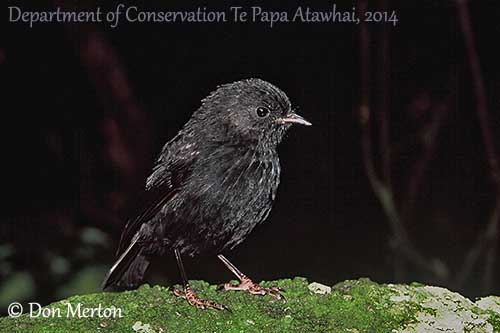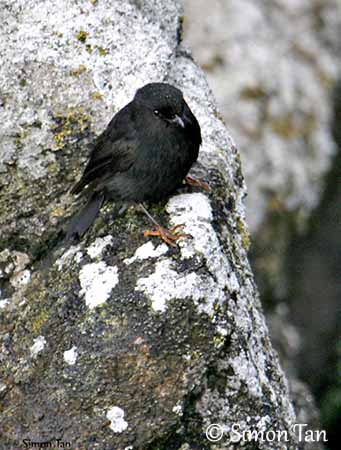
Fr: Miro des Chatham
Ang: Black Robin – Chatham Island Robin
All: Chathamschnäpper
Esp: Petroica de las Chatham
Ita: Balia melanica dell'Isola Chatham
Nd: Chathamvliegenvanger
Sd: Chathamsydhake
Photographers:
Don Merton,
Courtesy of Department of Conservation Te Papa Atawhai, 2014
Department of Conservation
Simon Tan (Tomtit)
PBase Bird galleries
Text by Nicole Bouglouan
Sources:
HANDBOOK OF THE BIRDS OF THE WORLD Vol 12 by Josep del Hoyo-Andrew Elliott-David Christie - Lynx Edicions - ISBN: 8496553423
BirdLife International (BirdLife International)
New Zealand bird status between 2008 and 2012
New Zealand birds and birding (Narena Olliver)
Wikipedia, the free encyclopaedia
Stories from Rangatira Island - The Black Robin Story
Home page
Page Passeriformes Order
Black Robin or Chatham Island Robin
Petroica traversi
Passeriformes Order – Petroicidae Family
INTRODUCTION:
Like almost all the Chatham’s bird species, the Black Robin is a rare bird.
The introduction of mammalian predators along with the human settlement has wiped out most of bird species from these islands, except from Little Mangere Island. However, this threat is still present.
The Black Robin’s story is fairly sad. All the currently living robins have similar DNA because they are descended from the same female, making them more vulnerable to diseases.
By 1972, only 18 Black Robins were found on Little Mangere Island. In 1976, there were only 7 birds left. In spite of the translocation of these birds to Mangere Island where there was more suitable habitat, 2 birds had died in 1980 and any breeding occurred.
Finally, the Black Robin was saved from extinction thanks to cross-fostering eggs and chicks to another species, in order to boost the productivity. And after several problems and failures, the last Black Robin breeding pair and the foster species, the Chatham Island Tomtit (Petroica macrocephala chathamensis) ended up saving the robins from extinction.
There is now a well-established population on Mangere and South East (Rangatira) Islands, and the Department of Conservation hopes to continue these works by establishing other populations on predator-free islands, especially on Pitt and Chatham Islands.
In 2011, the total population size was estimated at about 230 mature individuals and the numbers were slowly increasing, leading to 298 mature birds in 2013.

DESCRIPTION OF THE BIRD:
Biometrics:
Length: 15 cm
Weight: 22-25 g
The Black Robin from the Chatham Islands and the Snares Islands subspecies of the Tomtit (P.m. dannefaerdi) are completely black, and this melanistic plumage conceals the typical coloured pattern of the other species of genus Petroica. Several adult males have bright red, orange or pink patches on the underparts. These two species lack this distinctive pattern.
These peculiar features could be due to the absence of predators before the human settlement, when these birds were foraging on the ground. The dark colour was probably an adaptation to their mainly terrestrial behaviour. But more information is needed to explain this fact.

The Black Robin adults, male and female, are similar and completely black at all ages.
Bill, legs and feet are black. The eyes are dark brown.
The juvenile is black too, and shows fine pale streaking on crown and underparts.
RANGE:
The Black Robin was formerly present on the five major forested islands of the Chatham Islands group. But today, this species occurs on Rangatira (South East) Island which is a protected sanctuary.
HABITAT:
The Black Robin frequents forest interiors where it forages and breeds. This species rarely ventures outside forests, and does not breed well in more open areas with scattered vegetation.
The most suitable habitat is the forest with closed canopy, dense understorey and sheltering vegetation at the edges.
CALLS AND SONGS: SOUNDS BY XENO-CANTO
The Black Robin’s contact call is a single, high-pitched note also given in alarm or aggression. Territorial males and females give aggressive “chuck” and descending notes.
The song, usually given by males, is a series of 4-5 pure notes, usually less rich and melodious than the songs of the mainland robins. The repertoire of an individual may include 5-13 notes, sometimes more.
The most typical vocalizations include trills, piping notes and whistles.
BEHAVIOUR IN THE WILD:
The Black Robin feeds primarily on invertebrates, mainly insects, found on the forest floor while foraging among the leaf litter. It also forages in low vegetation. About half of preys are taken by being pounced on and some of them by sally-strike or flutter-chase. The usual preys are cockroaches, worms, wetas, flies, moths, bettles, caterpillars and spiders. Some berries can be eaten occasionally.
The breeding behaviour of the Black Robin is fairly similar to that of other Petroica relatives. They are very territorial during the breeding season, and they strongly defend their area. They are monogamous with long-term pair-bonds, and site and pair fidelity is high.
There are few courtship displays. Wing-flicking is part of these displays, with chases between mates, the male pursuing the female through the trees. Courtship feeding from male to female is also observed during courtship and through incubation.
The Black Robin is sedentary in its range. There is no natural migration between islands, as water and large open spaces does not allow long movement.
This species is very active and moves in short, rapid, direct flights from branch to branch. Its capacity of flight appears reduced.
REPRODUCTION OF THIS SPECIES:
The breeding season occurs in spring and summer. The breeding area is within forest interiors.
The female builds the nest, a cup-shaped structure, placed in a cavity in tree or among dense vines, often less than two metres above the ground.
The nest is made with twigs, bark and dry leaves, held together with spider web. The cup is lined with softer materials such as moss and feathers.
The laying occurs between October and late December. The female lays 1-3, usually 2 whitish eggs with dark markings. She incubates alone during 17-19 days, while the male feeds her. The black chicks are brooded by the female, but both parents feed and care them. They young leave the nest about 3 weeks after hatching, but they still depend on adults for food for 3-6 weeks after fledging.
This species may produce two broods per season.
PROTECTION / THREATS / STATUS:
The Black Robin has now stable population of about 298 mature individuals (2013). As it occurs on predator-free islands, the species is relatively secure, but it remains vulnerable to accidental predator incursions and diseases. In addition, the extent of suitable habitat is reduced, and a new location for a third breeding site is necessary to increase the population.
The Black Robin is currently classified as Endangered, due to the small population and the reduced range.